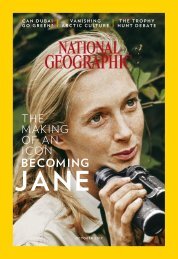NC
You also want an ePaper? Increase the reach of your titles
YUMPU automatically turns print PDFs into web optimized ePapers that Google loves.
opposition to projects endorsed by the Ruler.<br />
During the boom years this system produced<br />
Dubai’s headlong expansion and misbegotten<br />
projects like the World, an archipelago of 300<br />
artificial islands (shaped like countries) that<br />
remain largely uninhabited. But it also produced<br />
the Dubai Metro, a smashing success built in less<br />
than a decade and opened at the height of the<br />
financial crisis. Projects like that give sustainability<br />
mavens hope. “This country has developed<br />
so quickly,” says Tanzeed Alam, of the Emirates<br />
Wildlife Society. “It can change quickly too—<br />
because the leadership gets behind it.”<br />
Perhaps the greatest reason for hope is that<br />
environmental imperatives are coming into line<br />
with Dubai’s economic ones. It’s not just that<br />
solar energy is cheap. Dubai is pivoting now, says<br />
Rostock, because it has to—because it’s competing<br />
with other cities for business and people, and<br />
sustainability is in. “What we have is a willingness<br />
and a push to change Dubai and how it’s<br />
perceived,” Rostock says.<br />
But this city has no intention of slowing down.<br />
On a wall in Lootah’s office, a framed series of<br />
aerial pictures shows how Dubai has evolved since<br />
1935, when it was an impoverished fishing village.<br />
At the center is a visualization of the future: It<br />
shows a coast even more clogged with artificial<br />
islands than it is today. Dubai’s population is on<br />
track to double to more than five million by 2030.<br />
The city lives off its expanding footprint: Nearly a<br />
quarter of the population works in construction.<br />
The choke point, if one comes, will be water<br />
rather than energy. A shallow, almost closed sea,<br />
the Persian Gulf is already up to 20 percent saltier<br />
than the ocean, and it’s getting saltier: Dams in<br />
Turkey and Iraq are diverting freshwater, climate<br />
change is increasing evaporation—while making<br />
Dubai even hotter—and desalination plants are<br />
dumping hot brine. In time the water will become<br />
ever harder to desalinate and perhaps too salty to<br />
support a lot of the marine life that once supported<br />
Dubai. “We still feel we can cope,” says Lootah.<br />
With technology, “everything is possible.”<br />
With enough solar power even guilt-free<br />
indoor skiing becomes possible—and with climate<br />
change, Dubai may need the respite. In the<br />
summer, people already go outside as little as<br />
possible. By 2100 there may be days so hot and<br />
humid that going outside could kill you. Should<br />
this city even be here? I put the question to Alam.<br />
“That’s the wrong question,” he says. “It’s<br />
more about accepting where we are today and<br />
how do we make that better. It’s a question of the<br />
right to develop and of human beings’ right for a<br />
better future. How do we make cities better?” j<br />
Robert Kunzig and photographer<br />
Luca Locatelli<br />
<br />
DUBAI’S AUDACIOUS GOAL 69



